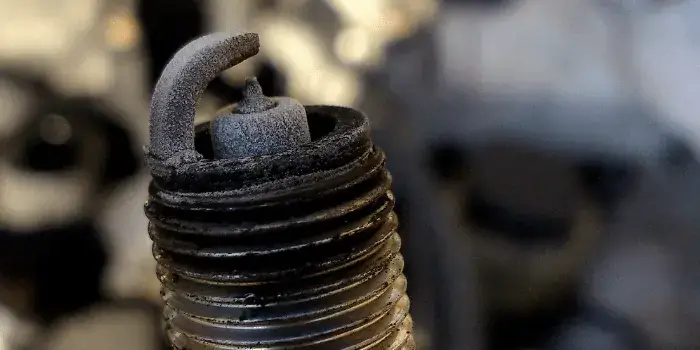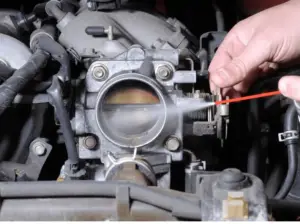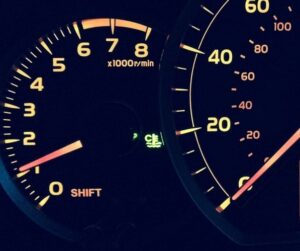Something is wrong if your car’s rpm varies without input from the throttle when parked.
Usually, the idle speed is 600 to 1000 rpm, which should remain fairly constant for your car when parked. If your car usually idles at 800 rpm, it should be about 50-100 RPMs within that.
Below we look at why your car RPM can go up and down when you’re parked and whether the fix is expensive or not.
Poor car maintenance resulting in clogged oil, fuel, and air filters normally causes this. Lesser likely causes are a clogged throttle body or a failing idle control valve.
It makes sense not to use the car more than necessary.
The good news is that this is usually not that expensive to fix in most cases (but not all).
Check Engine Light- Is It On?
If this is the case, take your car to a workshop or invest in a cheap OBD2 reader.
An OBD2 reader will take all the guesswork out of diagnosing your car. It will pay for itself many times over the lifetime of your car and cut down not only on car shop labor costs but also your precious time.
Do not drive the car if you have not got the cause of the check engine light being on. It could be a very serious issue that should not be ignored. The check engine light can mean serious trouble.
If the check engine is not on, some troubleshooting is needed.

Is your car running normally otherwise?
How is the fuel economy? Does it hesitate when you accelerate? Is it slower than usual? Is the throttle heavier than usual? Does the car sometimes stall during idle?
These questions are important to answer as they might indicate where the root cause.
For instance, poor fuel economy or unresponsive acceleration could point to the car running too rich, which means that too much fuel is being burnt and not enough oxygen is in the mixture. This would normally cause the car to Idle high but not always, as the air control intake valve may try and compensate and allow more air into the combustion chamber.
Idle Control Valve
The idle control valve ensures air flows to the engine when the throttle is not used. It is usually found near the throttle body, with rubber hoses running to it. If this is the culprit, the “check engine light” is usually lit, but not always.
The easiest way to check this is fairly straightforward.
- Start your car and listen closely. Do not have the radio, AC, fans, or other equipment when you do this. Check your idle rpm and how the tachometer behaves.
- Shut down the engine
- Unplug the air idle control valve
- Start the car again.
If everything is the same, this is the likely culprit.
You can remove the idle control valve and check it. If it is dirty or stuck, cleaning it might help. Otherwise, invest in a new one. They are fairly cheap.
Vacuum Leak
If it is not the idle control valve, a vacuum leak is a common cause of rough idle. This is usually associated with a slightly higher than usual idle RPM, and when it gets bad enough, the car won’t start.
You can check this by doing the following.
- Check all tubes coming from the intake manifold and air filter box. Check for cracks or collapsed tubes.
- Listening. With the engine on, listen for a “whistling” sound. It is sometimes distinctive enough to be heard through the engine noise.
- Use starter fluid.
By spraying starter fluid at or around connections and tubes and listening, one can accurately pinpoint the source of the leak. - A word of caution, however, one should be careful doing this if inexperienced, as it is possible to ignite the fluid if sprayed on a hot enough surface. Far better to use soap and water and check the bubbles.
Clogged Throttle Body
Remove the tube going into the throttle body and look inside.
It should look clean, with only metal visible. If there is oily residue and/or the throttle is hard to move, the body needs to be cleaned.
Do this with throttle body cleaner (available in most hardware stores) and some lint-free cloth (An old T-shirt also works fine). Usually, the throttle body doesn’t need to be removed.
Bad Fuel Pump
Usually, a bad fuel pump shows signs of failing not only when you are parked but also when you are driving. If you are experiencing poor acceleration and the RPM going up and down when you’re stationary, it could be the fuel pump.
The fuel pump is located near the fuel tank; when It goes bad, it can make a whining noise. You should still be able to notice this even if the car is running, although you may have to get out of the car and get closer to it to hear any problems.
Poorly Maintained Car
If none of the abovementioned checks solved the problem, check the following. All of the below issues point to poor maintenance and irregular tune-up intervals. Often just replacing these parts will solve the problem of your car’s RPM going up and down when you’re parked.
Bad Air Filter
Open the car’s air filter case and take a look at the filter.

A new filter is usually white or slightly off-white. If the one you are looking at is dirty, replace it. A bad air filter affects performance negatively in many ways and is cheap to replace.
A clogged air filter will stop the correct amount of air from entering the combustion chamber. If it is badly clogged, it may not catch all the contaminants entering your engine. This may not sound serious, but seeds or small plant debris entering the engine can cause significant harm.
Carbonized Spark Plugs
Without a spark, your car won’t fire correctly. The firing sequence is very important, and if you notice the RPM going up and then going down on a repeating pattern, it could be caused by defective spark plugs.
Remove the ignition caps (or coils, as modern cars often have coil-on-plug systems) and proceed to replace the spark plugs.

One can check them for defects, but a faulty spark plug is not always visible to the naked eye Unless it is heavily carbonized. Spark plugs should be replaced per manufacturers’ guidelines; generally, every 60000 miles or so is usually the recommendation.
Clogged Fuel Injectors
Spark plugs provide the spark, but fuel injectors spray the fuel into the combustion chamber. Usually, there are eight of these, and they spread and even spray patterns. If one or more is clogged, it can cause erratic idling, especially when parked.
In Conclusion
If your RPM is going up and down when you’re parked,
Firstly is the check engine light on. If so, this is a mixed blessing. It’s good that you can find the code that will point you to the problem. It’s bad because when the engine check light comes on, it normally indicates a more expensive problem.
If it is on, remember an OBD2 reader will save you a tonne of money and time by finding the code that relates to the problem quickly.
The problem generally relates to the engine’s air-fuel mixture if the light isn’t on. Either the air filter is clogged, or there are issues around the fuel injectors or spark plugs.
Vacuum leaks are a nice cheap fix that can be difficult to locate.
Rarely will the fuel pump be at fault, but they should be checked if the other issues are not the culprit.





![Can Low Oil Cause Rough Idle? [ANSWERED] low-oil-pressure-dash](https://carzaza.com/wp-content/uploads/2023/12/low-oil-pressure-dash-300x150.png)






